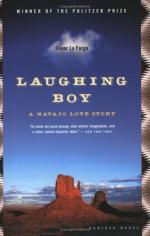|
This section contains 392 words (approx. 2 pages at 300 words per page) |

|
In his preface, La Farge explains that he chose to set the novel in an earlier time, before the first automobiles came to the Navajo reservation in 1915. In this way, he seeks to recapture an era when Native Americans had more of a choice between following the white man's way of life and their traditional way, passed from generation to generation. The Navajo way, called the "beautiful path" or hozoji, features an aesthetic and religious response to nature and reverence for the past. The Native Americans nurture this sense of beauty in their ceremonies—dances, prayers, and other religious observances—and incorporate it into their daily lives. To Laughing Boy, the novel's protagonist, hozoji means the creation of beauty in the silver and turquoise jewelry he makes, a skill he learned from his father, Two Bows.
Renouncing the white customs she has been taught, Slim Girl...
|
This section contains 392 words (approx. 2 pages at 300 words per page) |

|




